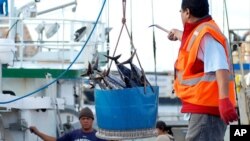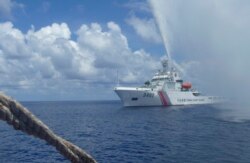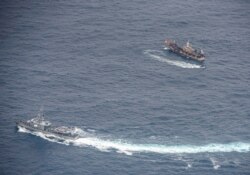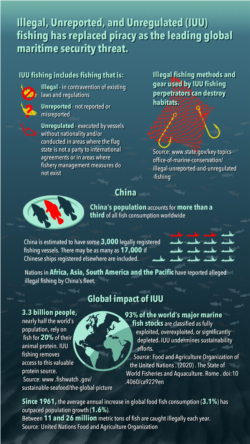Early morning in Honolulu, yellowfin, bigeye and other types of tuna, along with swordfish, are put up for auction after being offloaded from ships overnight. Longline boats, 145 of them, operate from this port, trailing kilometers-long baited lines. These vessels mostly fish in international waters at least 400 kilometers offshore, alongside boats from Taiwan, China, Japan and South Korea. Wholesale buyers compete for the catch in an early morning auction, and a single high-quality tuna can fetch from several hundred dollars to more than $1,000.
Confrontations are rare on the high seas near Hawaii, where the U.S. Indo-Pacific Command is based and the U.S. Coast Guard maintains a strong presence.
But fisherman here have watched with concern as Chinese fishing vessels intimidate Philippine fisherman in waters that China claims in the South China Sea.
In 2016, a United Nations-backed independent tribunal supported the Philippines in denying China's claims to the waters. China rejected the ruling, however, and Chinese ships still routinely engage in confrontations in the South China Sea with nations in the region that rely on its fishing grounds.
China is the world's largest producer and consumer of seafood, and critics say its fleets engage in aggressive tactics as the nation tries to feed its 1.4 billion people. Chinese ships have been accused of illegal and unreported fishing in many parts of the world — charges that China denies — and fishing industry officials in Hawaii worry about China's expanding footprint in the Pacific.
Reported aggression
Chinese ships have reportedly forced North Korean fisherman out of their own waters, and North Koreans sometimes fish illegally off the coast of Russia.
For crews in flimsy boats, things often end badly. Hundreds of so-called North Korean ghost ships have washed up in Japan, often containing the remains of fishermen. Some speculate they died of starvation after being forced by Chinese fleets into dangerous waters far from home.
Last year, a flotilla of 300 Chinese vessels alarmed environmentalists worldwide as ships massed along the exclusive economic zone of Ecuador, raising worldwide concerns about the impact on sensitive Galapagos Islands sea life. Satellite imagery suggests the fleet is approaching the area again this year.
Chinese vs. U.S. regulation
U.S. fishing vessels, on the other hand, face more scrutiny than the Chinese ships. They are closely monitored under U.S. domestic law, says Eric Kingma, executive director of the Hawaii Longline Association, which represents local fishermen.
"We have independent observer coverage levels of at least 20% in our tuna fishery, whereas China barely scratches (reaches) 5%. And we have a whole suite of environmental laws, statutes and regulations," he said.
China is not alone in its low level of monitoring, which meets the international standard, but critics say it is the most egregious in flouting the rules. The U.S. Coast Guard and National Oceanic and Atmospheric Administration have cited numerous allegations of illegal fishing by Chinese ships.
China's ocean footprint is huge. It has the world's largest long-distance fishing fleet, which it says it will cap it at 3,000 vessels. But a U.S. Coast Guard report says an additional fleet of 3,000 ships of the People's Armed Forces Maritime Militia "actively carries out aggressive behavior on the high seas and in sovereign waters of other nations" in pursuit of China's maritime interests.
People's Armed Forces Maritime
An estimate by the Overseas Development Institute, a British research center, puts China's total fleet size at nearly 17,000 vessels when Chinese ships that fly the flags of other nations are included.
Factories at sea
China operates in a gray zone, says Ethan Allen of the Daniel K. Inouye Asia-Pacific Center for Security Studies. Although the center is funded by the U.S. Department of Defense, Allen says his opinions are his own, and he believes China is threatening fish stocks as it pursues strategic goals using its massive resources.
"They have huge factory ships with whole flotillas of actual fishing vessels around them, and so they can move into an area and fish intensively and process a huge amount of fish in their big mother ship before leaving."
Some of China's expanded fishing activity is perfectly legal, carried out through joint ventures, by paying access fees, or through charter agreements with Pacific island nations that allow Chinese ships to fish their waters. Ten Pacific island nations have joined China's Belt and Road Initiative, a global infrastructure project.
One, Kiribati, is strategically located in the central Pacific and is conducting talks to build a Chinese-funded port and refurbish an air base once used by U.S. forces fighting Imperial Japan during World War Two. Kiribati officials say that project is civilian, not military.
But, regardless, the project is part of China's worldwide outreach. A 2019 report from the Center for Strategic and International Studies found that 46 existing or planned port projects in sub-Saharan Africa had been funded, built or operated by Chinese entities.
Samoa leader concerned
One leader in the Pacific has been pushing back, however. Samoa's new prime minister has canceled plans for a controversial Chinese-financed port supported by her predecessor. Fiame Naomi Mata'afa, the nation's first woman leader, told Reuters last week that the United States had effectively "moved out" of the region, but she expressed concerns about being caught between two superpowers. She also worries about her nation's growing debt with China, its largest creditor.
The nearby U.S. territory of American Samoa has seen its catch of albacore, the target fish that is central to its economy, slashed by Chinese fleets that surround its waters, says Mark Fitchett, a scientist at the Western Pacific Regional Fishery Management Council, one of eight regional bodies authorized by Congress to manage U.S. fisheries.
"You have one player that doesn't seem to have any controls on the expansion of its fishing fleet and on its capacity to extract these renewable resources. It's of great concern to us," Fitchett said.
The U.S. Coast Guard report, citing a U.N. statistic, says 93% of the world's marine fish stocks are fully exploited, overexploited or significantly depleted. Fitchett says principal tropical tuna stocks that Pacific fisherman target — bigeye, yellowfin, skipjack and albacore — are not now overfished, but "they're shared resources and they're not inexhaustible."
Following one guideline will keep it that way, says John Kaneko, program manager at the Hawaii Seafood Council. "Simply, don't take more than the natural system can replenish year after year," he said, and increase the level of international monitoring to ensure that catches are accurately reported and rules are enforced.
Individual nations have complained about China's behavior, but, says analyst Ethan Allen, "there's not yet a unified voice and any real backing of it" through sanctions or other measures to increase incentives for China to change how its fleets operate.















